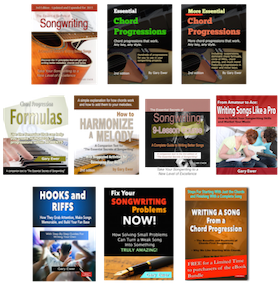On November 3, both the CNN and BBC, as well as many other news outlets, reported new research, published in “Psychology of Aesthetics, Creativity and the Arts“, into the issue of earworms: what makes an earworm, and why some songs are more likely than others to possess the characteristics of an earworm.
CNN refers to the research by music psychologist Kelly Jakubowski and her team, saying that they “…identified three main reasons why they occur, and it comes down to pace, the shape of the melody and a few unique intervals that make a song stand out.”
I haven’t read the research yet, but there seems to be a glaring omission, at least from the reporting of this topic: the role that chord progressions play in how likely it is that a song might become an earworm. In fact, I would argue that the three factors they mention (tempo, melodic shape, and a unique interval) is a better description of a standard hook, and as we know, a great hook can sell lots of songs, but doesn’t necessarily mean that it will become an earworm.
 “How to Harmonize a Melody” shows you, step by step, how to choose the chords that will work with your melody, how to substitute chords, and how to make more complex progressions work for you. Buy it separately, or as part of “The Essential Secrets of Songwriting” 10-eBook Bundle.
“How to Harmonize a Melody” shows you, step by step, how to choose the chords that will work with your melody, how to substitute chords, and how to make more complex progressions work for you. Buy it separately, or as part of “The Essential Secrets of Songwriting” 10-eBook Bundle.
The Possible Role of Chord Progressions in Earworms
If you look at the list of songs that the CNN article mentions as being most reported as being an earworm, you get the characteristics they mention: the quick tempo, the short, catchy melodic shape, and at least one unique interval.
What they don’t mention is the role that an open cadence plays, and I would argue that open cadences do more to keep an earworm melody rattling around in your brain than practically anything else. Here’s how an open cadence works.
The Open Cadence
In music, a cadence refers to the end of a chord progression. When you play a I-IV-V-I progression, the V-I part is the cadence. A cadence provides a moment of “rest”, when it sounds to a listener as though that short musical journey that the progression represents is finished.
Sometimes that rest is a temporary one, like the one you get with this progression:
I-vi-ii-V (C-Am-Dm-G)
…and sometimes that progression has a more final sound, such as with the the I-IV-V-I progression I mentioned.
An open cadence refers to the end of a musical phrase when it doesn’t stop on a I-chord, and usually means that its final chord wants to make a connection back to the I-chord. So here’s an example of a progression with an open cadence:
I-IV-ii-V-vi-IV-Vsus4-V (C-F-Dm-G-Am-F-Gsus4-G)

As you can see, the G-chord that ends that progression (V) wants to connect back to the C-chord at the beginning (I), because that’s what V-chords typically do: they move smoothly and seamlessly to a I-chord.
And because the I-chord starts the entire progression again, you’ve got a progression that wants to keep repeating, over and over: the beginning of one phrase is the ending of the previous one, and so it represents an endless (earworm-ingly frustrating, to some) loop.
And to my mind, that’s one crucial part of what makes a song catchy. The fact that its main progression wants to keep repeating is an important component of many songs that get mentioned as earworms.
The Earworm List
So if you look at the list of songs provided in the study, and reprinted in the CNN article, you’ll notice that most of them feature this important chord progression characteristic: the open cadence.
Sometimes, in the case of Lady Gaga’s “Poker Face”, the chorus progression is a short progression: Am-G (original key Ab minor), and similarly for “Somebody That I Used to Know”: Dm-C.
In “Bohemian Rhapsody”, you’d be hard-pressed to find any progression that doesn’t feature an open cadence. For most of the many progressions in this song, the end of one progression is the first chord of the next phrase.
This is not to say that the catchiness of the melody is inconsequential. I would say that it’s an important feature, and you’re unlikely to keep singing a melody that isn’t ultimately singable, something with an enticing shape, an attractive interval, and with a good, energetic tempo.
But if you really want to bless (or curse) your audience with your own earworm melody, don’t forget the important role that the open cadence plays in keeping melodies cycling endlessly.
Written by Gary Ewer. Follow Gary on Twitter

 Do you simply need some chords to get you started? “Essential Chord Progressions“, and “More Essential Chord Progressions” are part of “The Essential Secrets of Songwriting” eBook Bundle packages. Hundreds of chords to use as is, or modify to better suit your songs. Get today’s Deluxe Bundle Deal
Do you simply need some chords to get you started? “Essential Chord Progressions“, and “More Essential Chord Progressions” are part of “The Essential Secrets of Songwriting” eBook Bundle packages. Hundreds of chords to use as is, or modify to better suit your songs. Get today’s Deluxe Bundle Deal











THAT’S IT! Open Cadence. That really makes sense.
Oh, how I detest earworms. They have actually woken me up.
I find that if I ever lie awake at night, I always have some earworm going through my mind. I’ve tried to figure out if there’s anything in common between the various tunes, but haven’t come up with anything obvious.
-G